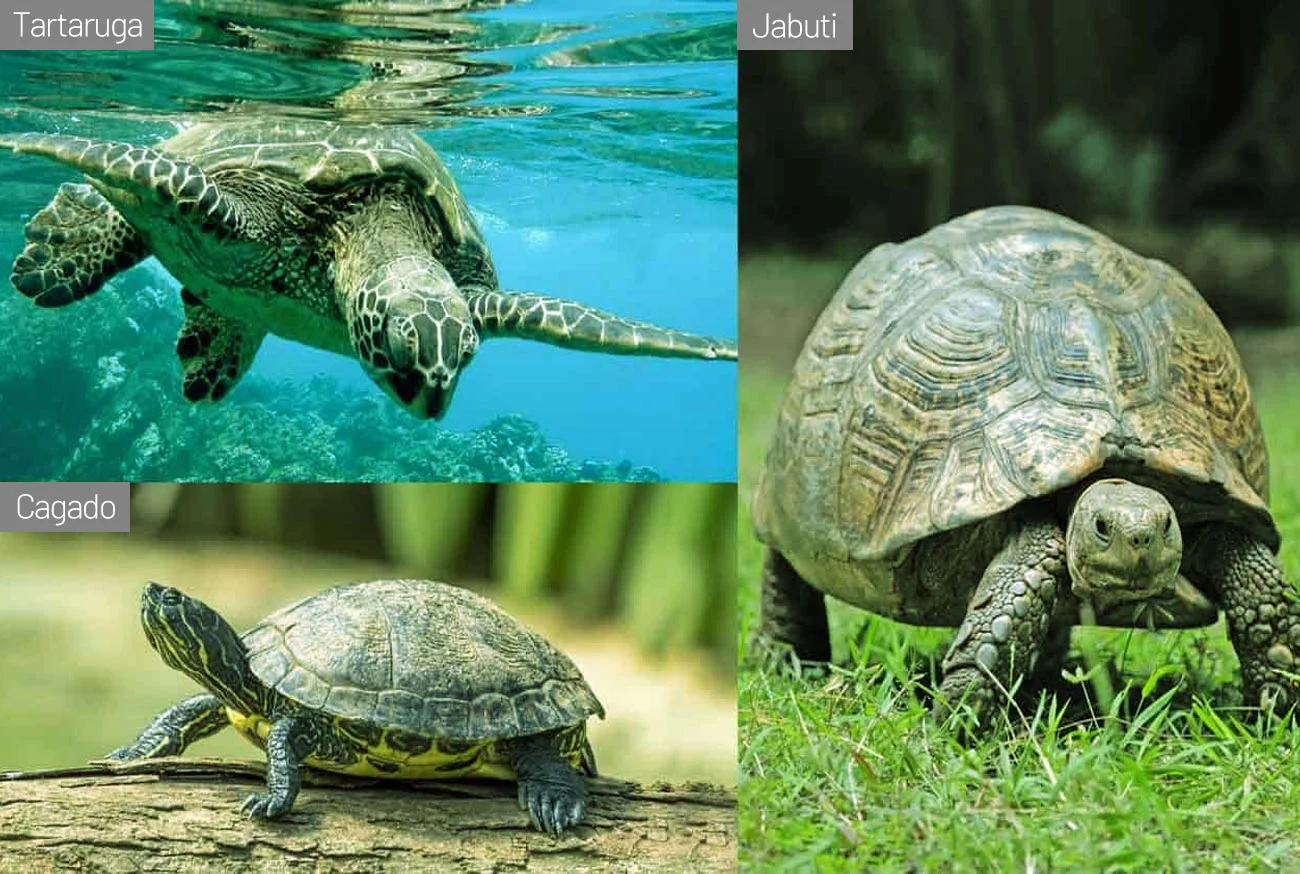If you've ever found yourself trying to figure out which is which, you're in the right place! In this post, we'll dive into the fascinating world of reptiles and finally clarify the differences between terrapins, tortoises, and turtles. Get ready to learn in a practical way, with curiosities and surprising details that will change how you see these incredible animals.
What are reptiles, and what is their connection to terrapins, tortoises, and turtles?
Reptiles are a class of vertebrate animals characterized by having skin covered with scales or plates and being ectothermic, meaning they depend on external temperature to regulate their body heat. Among reptiles, we find snakes, lizards, crocodiles, and of course, the beloved terrapins, tortoises, and turtles.
These three animals belong to the order Testudines, but each has unique traits that set them apart. To better understand, let's explore the specific characteristics of each one.

Terrapins: The freshwater swimmers
Terrapins are aquatic reptiles that primarily inhabit rivers, lakes, and marshes. They have limbs adapted for swimming, with webbed toes that make them excellent swimmers.
One of the main characteristics of terrapins is their flat and lightweight shell, designed to facilitate movement in water. They also have long necks, which allow them to quickly capture prey or breathe without fully emerging from the water.
Curiosities about Terrapins
- They primarily feed on fish, small insects, and aquatic plants.
- Unlike turtles, they prefer calm freshwater environments.
- Some terrapin species can live up to 40 years!
Practical tip: If you find a shelled animal in a river or lake with limbs resembling fins, you're likely looking at a terrapin.
Tortoises: The land dwellers
Tortoises are strictly terrestrial reptiles. They have robust, rounded legs, ideal for walking on land. Their shell is more elevated and rounded, giving them a unique and easily identifiable appearance.
A distinctive trait of tortoises is their predominantly herbivorous diet. They feed on fruits, leaves, and even flowers, making them peaceful and slow-moving animals.
Curiosities about Tortoises
- Tortoises can live over 80 years in captivity, known for their longevity.
- In Brazil, the most well-known species are the red-footed tortoise and the yellow-footed tortoise.
- These animals have curious behavior: they love sunbathing, which is essential for their health.
Interesting note: Despite being terrestrial, tortoises can cross shallow water without any issues.
Turtles: The ocean adventurers
Turtles are marine reptiles that spend most of their lives in the ocean. Their limbs have evolved into flippers, allowing them to move gracefully in water.
Their shell is more streamlined compared to tortoises and terrapins, reducing water resistance while swimming. Additionally, they have an impressive migratory instinct, traveling thousands of kilometers in search of feeding or breeding grounds.
Curiosities about Turtles
- Sea turtles can live over 100 years!
- They have an incredible ability to return to the place where they were born to lay their eggs.
- Their diet varies by species but may include algae, jellyfish, and small crustaceans.
Fascinating fact: Despite being marine animals, turtles always return to land to lay their eggs, digging nests on sandy beaches.
How to differentiate them in practice?
While the differences between terrapins, tortoises, and turtles are clear, let's recap the main distinctions for easy understanding:
- Habitat:
- Terrapins: rivers and lakes.
- Tortoises: land.
- Turtles: oceans and seas.
- Limbs:
- Terrapins: swimming membranes.
- Tortoises: cylindrical and strong legs for walking.
- Sea Turtles: long flippers.
- Shell:
- Terrapins: flat and light.
- Tortoises: high and rounded.
- Sea Turtles: streamlined.
- Diet:
- Terrapins: carnivorous and omnivorous.
- Tortoises: predominantly herbivorous.
- Sea Turtles: varies by species.
Bonus Tip: The shape of their legs is the most practical way to quickly identify the type of reptile you are observing.
The importance of terrapins, tortoises, and turtles in conservation
Unfortunately, many species of terrapins, tortoises, and sea turtles are threatened with extinction. Habitat loss, pollution, and illegal wildlife trade are some of the main causes of these reptiles' population decline.
Each of these animals plays an essential role in the ecosystems they inhabit. Preserving them is vital not only to maintain environmental balance but also to ensure that future generations can admire these incredible creatures.
Now that you know the differences between terrapins, tortoises, and turtles, it’s easier to identify each one and understand their unique traits. These reptiles are fascinating and play important roles in the environment.
If this post helped you clarify doubts or learn something new, share it with your friends! Spreading knowledge about nature is one of the best ways to preserve it.
What people also search for about terrapins, tortoises, and turtles
Is it easy to keep terrapins, tortoises, and turtles?
Keeping these animals requires specific care, as each species has different needs. For example, terrapins need an environment with clean water to swim in, while tortoises require ample terrestrial space and access to fresh food. On the other hand, sea turtles cannot be legally kept in captivity as they are protected by environmental laws.
Although they do not demand constant interaction, it is necessary to dedicate time and resources to provide a suitable and healthy habitat, as well as specialized veterinary care.
Can terrapins, tortoises, and turtles be kept as pets?
Yes, terrapins and tortoises can be kept as pets, as long as they are acquired legally and the environment provides adequate conditions for their species. It is important to purchase these animals from breeders authorized by IBAMA to ensure that their acquisition does not contribute to the illegal wildlife trade.
Sea turtles, however, cannot be kept as pets since they are protected by environmental laws due to their risk of extinction.
What law protects terrapins, tortoises, and turtles?
In Brazil, the protection of these animals is guaranteed by the Environmental Crimes Law (Law No. 9.605/1998). Additionally, IBAMA regulates the breeding and commercialization of species, requiring that any breeding or sale be conducted responsibly and with authorization.
In the case of sea turtles, they are also protected by conservation programs such as the Projeto Tamar, which works to preserve their habitats and combat illegal trade.
Are terrapins, tortoises, and turtles native to Brazil?
Yes, Brazil is home to various species of terrapins, tortoises, and sea turtles. For example, the tortoise species Jabuti-piranga and Jabuti-tinga are found in tropical forests and cerrado areas. Terrapins inhabit rivers and lakes in different regions of the country.
As for sea turtles, some species like the green sea turtle and hawksbill sea turtle frequent Brazilian waters for feeding and nesting, although their main habitat is the ocean.
Don't be an accomplice!
If you know someone keeping wild animals illegally, report it anonymously. Contact IBAMA by phone at 0800 618080 or send an email to
Download Portaria-IBAMA-93-1998 to see which animals are authorized for keeping as pets.

















Add comment